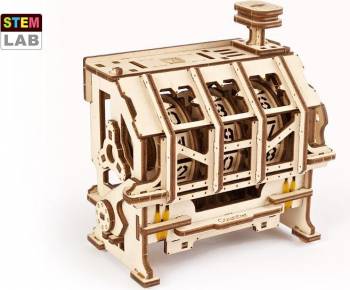70130 STEM LAB Counter
Assemble it and discover the principle of working of the Three-digit Clicker-Counter
- Experiment: the model comes with a Pocket Model’s Study Guide with a creation story and mechanism design as well as engaging and interesting tasks.
- Immerse yourself in Augmented Reality (AR), find out how the Counter is used in a production line, and interact with it via the dedicated Ugears application.
Learn how the COUNTER works
The Counter is a stylised educational model, an interactive study guide to the mechanism, only for learning its essentials and principles of working. It registers repetitive actions. It is an integral part of a device called an “Odometer”. The model has three cylinder gears with numbers from 0 to 9 and a Geneva Drive. This combination allows you to see an interesting mechanical feature: when the reciprocating motion of the click-button using the Geneva Drive mechanism turns into the rotary motion of the cylinder gears with numbers. The Counter provides two options of data registering: click-button on the roof of its body, and a turn handle on its side. Pressing the click-button or turning the handle makes the Counter shift by one place. When the count passes 9, the Geneva Drive catches the next register cylinder and adds it to the count. Altogether, the three-digit display of the Counter can register values from 1 to 999. You can open the front panel of the counter and reset it manually. Try counting steps on your way home. Or how many people you meet on a stroll through the park. How about, the number of blue cars passing by your house during one hour? Count stairs at home, at school, or at a friend’s house.
When and who invented it
A counter, as a key part of the odometer mechanism, was invented by an Ancient Greek mathematician and engineer Hero of Alexandria who lived in 10-70 AD. It measured the length of the path by counting the number of rotations of the wheel. Later, the counter was improved and completed with a reducer that reduced the number of the wheel's revolutions depending on the measuring system (miles, leagues, kilometers) and showed reduced data on the display.
Usage
These days, counters are used to count the number of passengers, visitors of different events, cars passing through certain check point, sets and scores in sport, items on a production line, etc.

